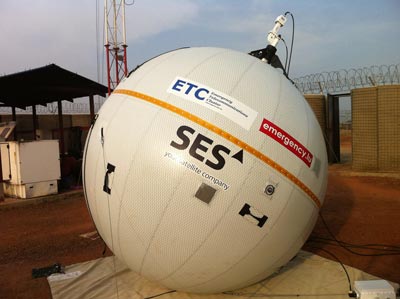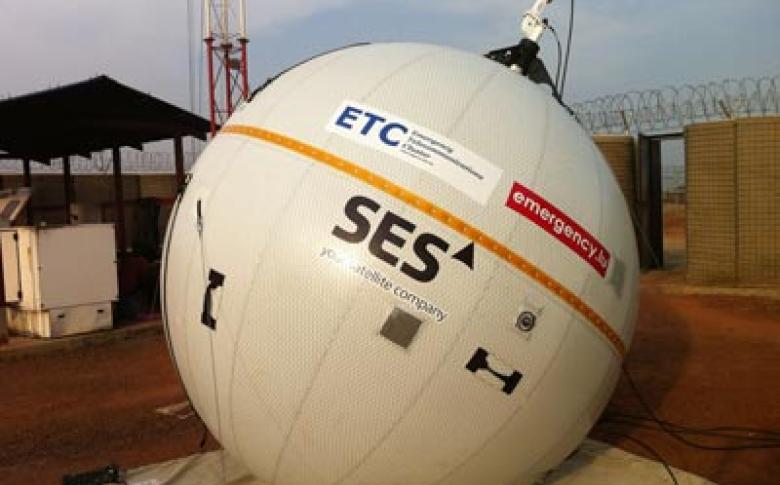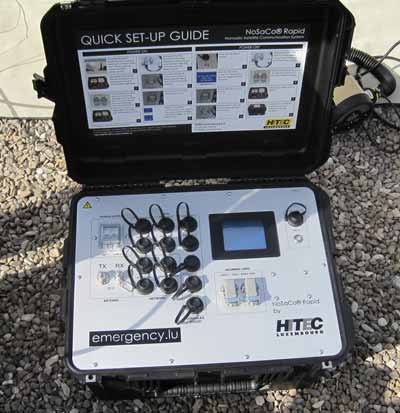
Beach ball for emergency response

Covered in bright logos and resembling a hot air balloon fighting to bust free, the inflatable emergency.lu. satellite antenna – as part of the Emergency Telecommunications Cluster response solution – has been providing high-speed internet connectivity to the humanitarian community in South Sudan since January 2012.
The inflatable antenna is part of the emergency.lu Rapid Deployment Kit to provide high-speed communication support to humanitarian organizations in emergencies. The complete emergency.lu solution is a global public good funded by the Luxembourg Government for the benefit of the humanitarian community as a whole. The first deployment of the Rapid Deployment Kit was in Bentiu, South Sudan. Essentially a big beach ball, the terminal has a dish inside which separates it into two parts, each with its own air supply. A pump expels air at different pressures to the two parts to achieve the dish’s parabolic shape. The dish is made of a sturdy cloth, covered with a special coating, which reflects and concentrates electromagnetic waves in the same way as a conventional satellite dish.

On top of the antenna is a feed horn, which, together with the modem and the rest of the RF (radio frequency) equipment, constitutes a standard iDirect unit. The iDirect system is used extensively throughout the humanitarian community and for VSAT connectivity in general. The emergency.lu VSAT network has almost global reach with four-megahertz capacity per geographical region shared between terminals. The system makes use of C-band frequencies to make it less sensitive to atmospheric disturbances and generally provide a more reliable connection. Internet access to the users is provided through WIDER, the Ericsson Response Wi-Fi solution, which is connected to the terminal.

The inflatable antenna is anchored to the ground with lines at four corners, using a combination of metal stakes and ballast to keep it stable. Installed properly, the antenna can withstand a wind force of 65 km/h. Fine-tuning of the antenna is done through adjusting the anchor lines, thereby slightly changing the orientation. One of the key advantages of the inflatable antennas is that it can be set-up and configured very rapidly - the fastest installation was in just 20 minutes! Another great advantage is the portability of the system; consisting of just five boxes with an average weight of 21 kilogrammes each, the emergency.lu Rapid Deployment Kit is easily transportable and can be airline-checked by humanitarian emergency responders.
The inflatable antenna is only for the first phase of an emergency response. A Regular Deployment Kit, comprising a more robust metal dish, is deployed from stand-by stock at the same time as the announcement of the emergency as a second-phase solution. The Regular Kit resembles a standard dish but is designed specifically for emergency operations. Once on the ground, it can also be very quickly and easily installed. The Regular Deployment Kit is being used in Pibor and Renk in South Sudan.
The emergency.lu satellite connectivity provides the basis of the Emergency Telecommunications Cluster (ETC) response solution. As lead of the ETC in South Sudan, WFP is mandated to extend services from the common operational area to five additional locations. In addition to the satellite terminals, therefore, the both emergency.lu deployment kits contain the NoSaCo (Nomadic Satellite Communications) Rapid satellite communication system, which provides local area network and access to services such as voice connectivity, collaboration and eventually the pioneering Emergency Preparedness Integration Centre (EPIC).
So far, emergency.lu kits have been prepositioned in Luxembourg and Dubai for rapid deployment across the globe but they will also be sent to Panama in the coming months. The Let’s Net course, coordinated by WFP, trains IT emergency responders how to deploy these systems. To date, 32 responders have successfully completed this course and are on stand-by for the next crisis.
By Rob Buurveld and Mariko Hall